Nanchang CJ-6
Trumpeter (02240)
1:32
Started: Apr 2007
Finished: Aug 2007
Link to Gallery
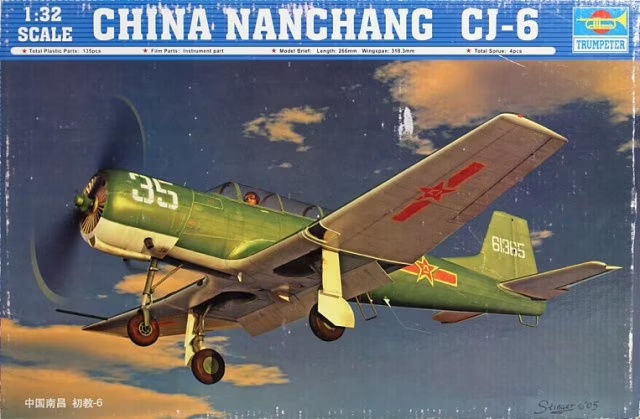
The CJ-6 (Chu Jiao 初教 = Chuji Jiaolianji 初级教练机 = basic trainer aircraft) is an all-original Chinese design that is commonly mistaken for a Yak-18A. Its predecessor, the Nanchang CJ-5, was a licence-built version of the Yak-18. However, advancements in pilot training brought a need for a new aircraft with improved performance and a tricycle landing gear. When the Soviet Union developed the Yak-18A, PLAAF engineers decided that its performance and design would not suit China's needs.
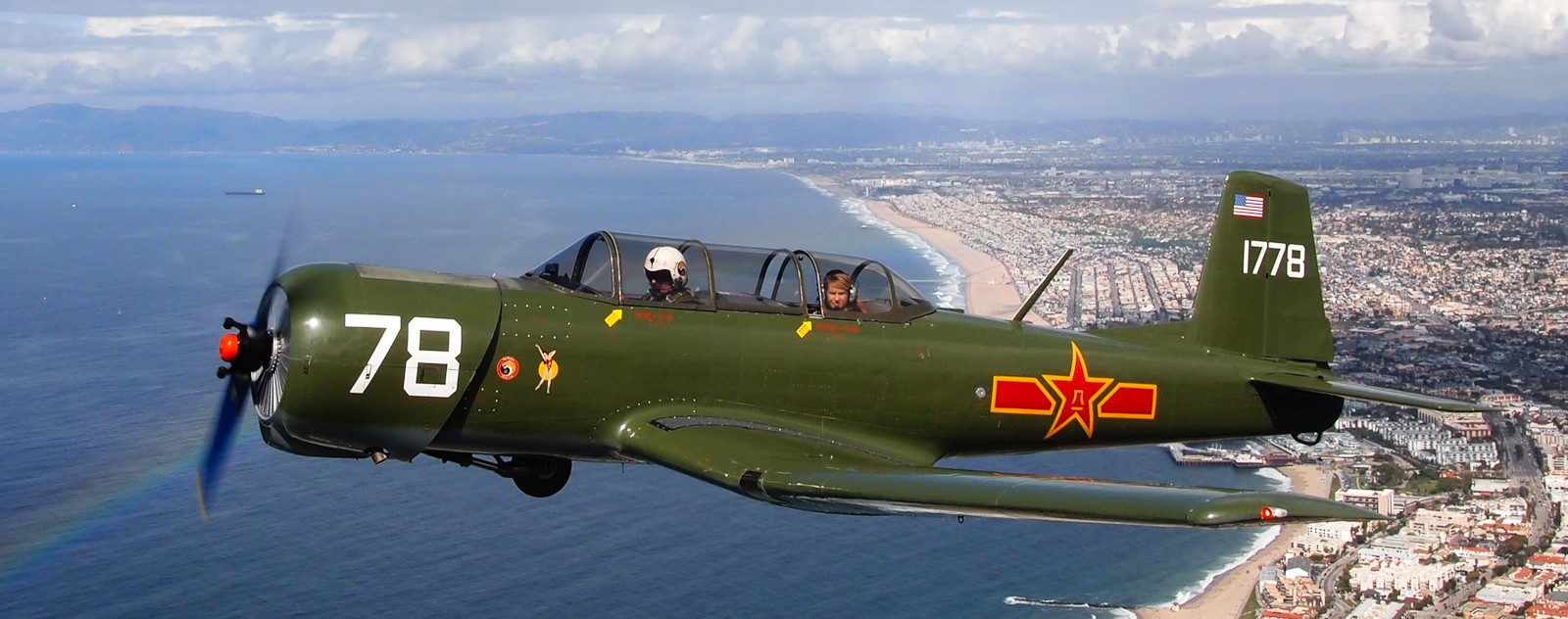
The aircraft was designed in 1958 by the Nanchang Aircraft Factory (now Hongdu Aviation). As the Shenyang Aircraft Factory already had experience building the Shenyang JJ-1 begun technical research for the CJ-6, more than 20 Shenyang designers were transferred to Nanchang, including chief designers Tu Jida and Lin Jiahua.[2] Xu Shunshou and Huang Zhiqian, then China's top aircraft designers, were also involved
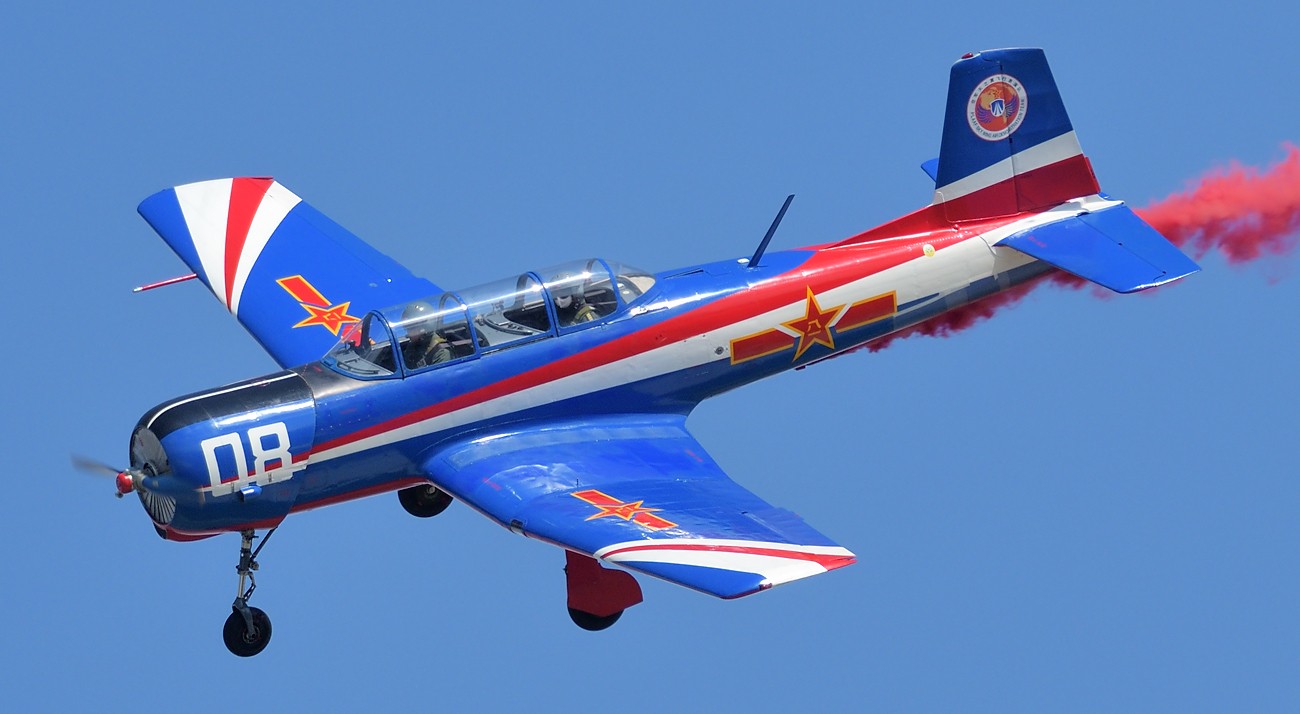
Power for the prototype was provided by a Czech-built horizontally-opposed piston engine, but flight testing revealed the need for more power, so a locally manufactured version of the Soviet AI-14P 260 hp radial, the Housai HS-6, was substituted along with a matching propeller, and with that change the CJ-6 was approved for mass production. In 1965 the HS-6 engine was upgraded to 285 hp and redesignated the HS-6A, and the aircraft equipped with the new power plant were designated the CJ-6A. A total production run estimated at more than 3,000 aircraft supplied CJ-6 aircraft for PLAAF training, as well as for export (as the PT-6) to countries including Albania, Bangladesh, Cambodia, North Korea, Tanzania, and Sri Lanka. CJ-6 attained its civil aviation type certificate on February 28, 2019, more than 60 years after it entered military service in China.
KIT OVERVIEW - Trumpeter 1:32 Nanchang CJ-6 (TR02240)
My first Trumpeter aircraft, also my first 1/32 build for some time. Overall I was quite impressed with the quality of this kit. The paint scheme and markings represent a CJ6 in private (US I'd guess) operation

BUILD - Trumpeter 1:32 Nanchang CJ-6 (TR02240)
As normal, first step is to familiarise myself with the fit of the kit. Its also the time to start planning what needs to be fixed and added. You can only analyse a kit so much when it is sitting in the box. Its not until you dry fit the pieces you can see what you are really in for
.jpg)
The wing of the CJ-6 has a large down facing landing light cavity. Here we can see the lower surface of the wing and the nasty sprue mark I will have to sand and buff to remove (groan, why can't things ever be easy)

The kit interior detail is not all that bad. Some minor additions add some interest. Perhaps the most work was to fill and sand the ejection pin marks and then replace all the bolt heads from punched discs. A lot of work, but no real choice as this part of the cockpit is VERY visible.

The wiring looms have been made from about 5 strands of 0.125mm copper wire, twisted together. To try and simulate the cable ties I have used small sections of Tamiya tape. This worked ok, but I will try and come up with a better idea next time

The shroud which sits between the front and rear cockpit benefits from some simple enhancements. The 30thou lip was fastened using super glue and the gap blended in using Tamiya Basic Putty

Here I have most of the cockpit and fuselage parts awaiting a first coat of paint. I like to use the self closing tweezers to hold parts when painting

This is the first time I have used the Trumpeter clear instrument panels. Maybe I'm missing the point, but why are they clear ???

Trumpeter provides acetate dials (ala Eduard PE) that are designed to be placed behind the panels and visible thru the open holes. Only problem is that unlike PE instrument panels, the plastic versions are way too thick. End result would be that the dial faces are at the bottom of a deep hole and barely visible. I decided to fix this problem by putting a blanking plate on the rear of the panel

With the blanking plate in place, I now need to fill (almost) each instrument hole. Then I can punch out each dial from the acetate and glue it from the front. Here you can see an example with a 20thou disc being punched out. This will almost (depth wise) fill the largest instrument hole

Both front and rear instrument panels have each hole filled with appropriate sized discs. These discs are easy to create using my trusty (and rather rusty I just noticed) Waldron Punch and Die set

With all the holes filled, its time for coat of paint (Taimya XF-19 Sky Grey). With the grey paint, its much easier to see how the holes are now much shallower

The kit seats are not bad in shape, but come with no harnesses. I have used some Lion Roar PE belts to do the job. These belts are from a 1/48 Luftwaffe set. Not strictly accurate but they look ok (and even in scale ???)

With the black detail painting complete, it was time to start attaching the punched acetate dials. However, at this point, fate had other ideas. The trumpeter dials did not want to cleanly punch out (I wrecked 4 in a row and decided to give up on that idea). Problem solving is all part of the game with modelling, so I had a think and decided that I could use the instrument decal sheets I had from Reheat (no longer in business). Only glitch here was that the decals are clear (ie no white backing) so I needed to make the dial faces white somehow before applying the dial decals. For this I also used decal (rather than paint) as it was quicker and more accurate. A sheet of white decal paper (from Superscale) came to the rescue

Here is how the individual dials where punched out from the sheet. As I have a limited supply of the Reheat sheets I will need to source a new supplier (I believe Mike Grant does some sheets).

After a couple of hours of punching and decaling the panels start to look better

Once the instrument panels where complete the rest of the cockpit came to together quickly

The cockpit is mostly out-of-the-box. The harnesses and small scratchbuilt details (like the throttle handles etc) add more detail for the eye to pickup on

I am quite happy with how the sidewall wiring looms turned out. Here the front cockpit is shown to good effect

The rear cockpit is simpler than the front, but still looks busy

With the cockpit complete, its time to glue up the fuselage. The clamps help to ensure no unexpected gaps sneak in

Some testing showed that without some serious nose weight, this puppy is going to be a major tail sitter. Using plasticard I have boxed off the front of the cockpit so that I can fill it full of lead
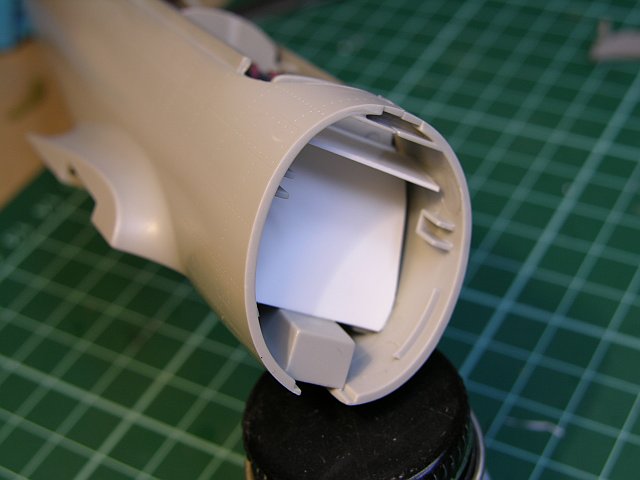
Using small lead shot (fishing sinkers) I have super glued them to the home made firewall

Work on the wings has continued while the fuselage dries. Here we see that large wing landing light glass section. Rather than spend time and effort boxing it in, I tried simply painting it black inside to see how it looked. It worked just fine
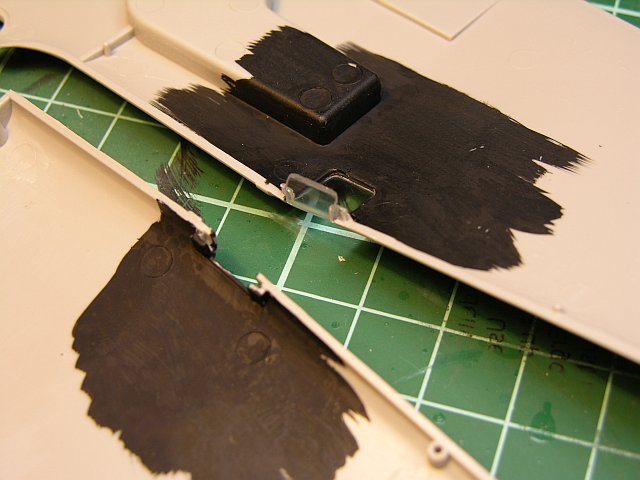
Last task for today was gluing the wings and seting them aside to dry

Cleanup of the canopies has been completed and the test fitting shows that Trumpeter is on the money with this one. A very snug fit
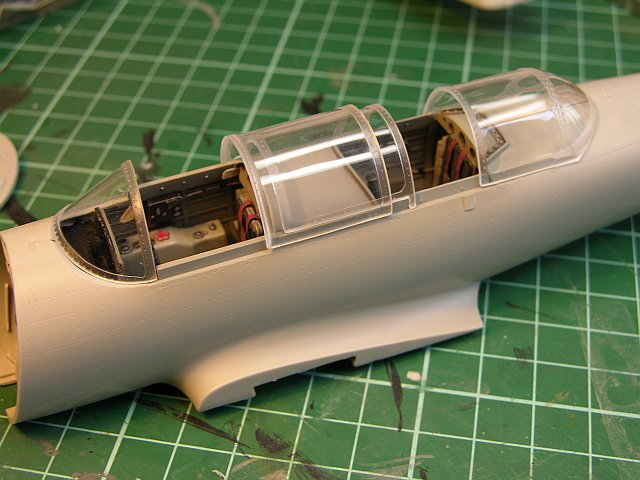
With the fuselage seams cleaned and sanded, its to replace panel lines and rivets. Here I have marked out where the rivets will go with pencil

Speaking of rivets, this model has a lot of rivets. Here you see the wing leading edge resting on the fuselage to show how the rivets even go around the wing
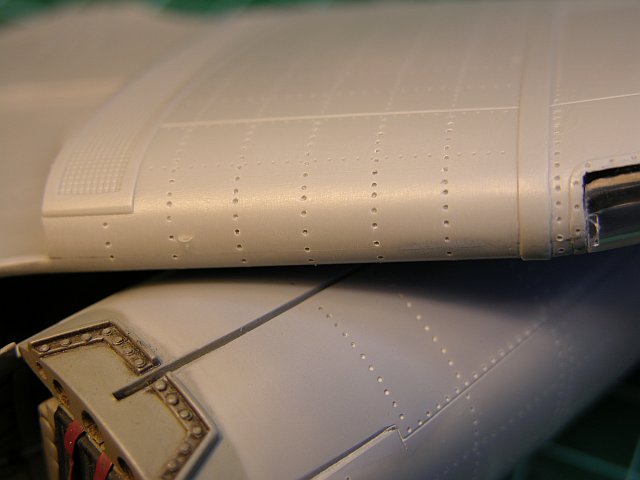
Did I mention that this model has lots of rivets (I'm seeing rivets in my sleep). Unfortunately the molding process seems to have left almost all the fuselage and most of the wing rivets very shallow and very likely to disappear once painted. So, wishing to eventually apply a wash to the rivets, I undertook the major task of re-drilling each and every rivet (yes each one)

For the rivet drilling process I used a #79 drill in a pinvise. To do the whole airframe took 3 days (I mean full days, not just evenings). I am a bit worried that the drill I used may be a bit large even for 1/32 scale. I won't really know until I have the paint on and applied the the wash. Fingers crossed
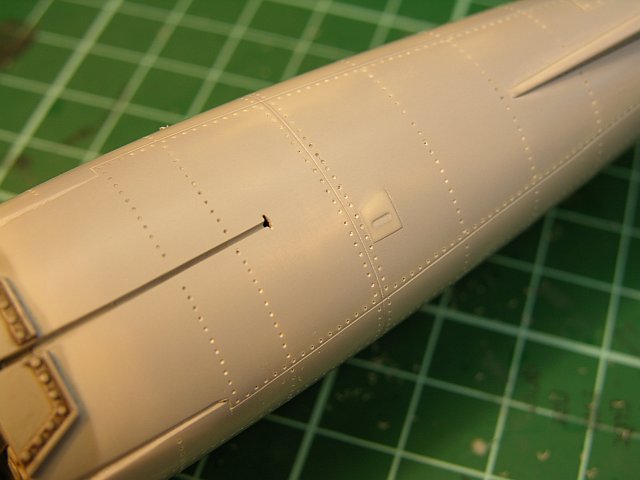
With the cleanup (did I mention the rivets) complete, its time to bring the fuselage and wings together. The fit really is not as bad the photo would indicate. I like to use clamps even on good fitting parts to ensure nothing un-expected happens as the glue dries
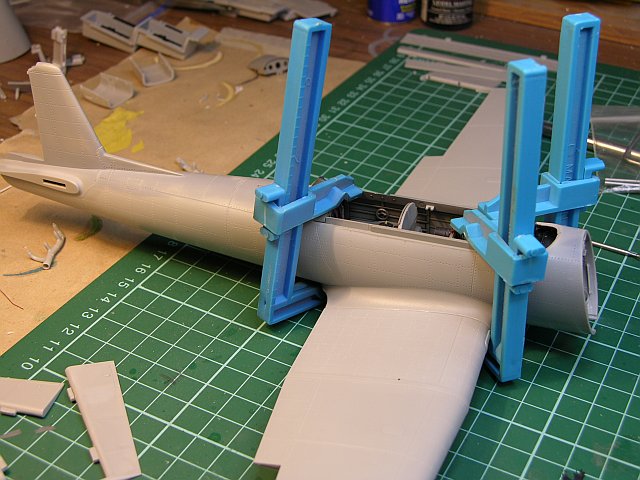
When I earlier added the small sinker weights to the fuselage interior, I knew that it would not be enough, but I never realised it would take so much weight to stop this sucker from tail sitting. My challenge now is to try and make all that lead fit inside the cowling

I've started the process of attaching the lead sinkers to the kit parts. Here I have used lockwire, passed thru holes in the sinker (ever tried drilling lead ?) to hold it in place. You will notice that I have not paid any attention to the detail cleanup of the engine parts as they will not be visible at all
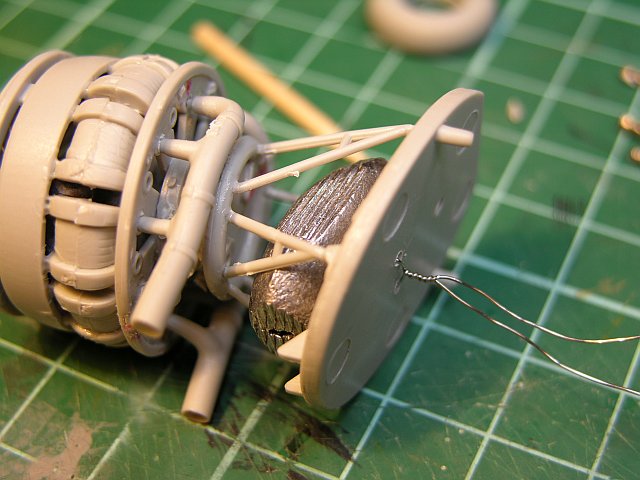
With the wing/fuselage joint sanded in, its time to restore the rivet detail lost in the process. A small strip of Tamiya tape acts as a suitably flexible curved guide for a pencil to mark the correct shape line where the rivets will be drilled
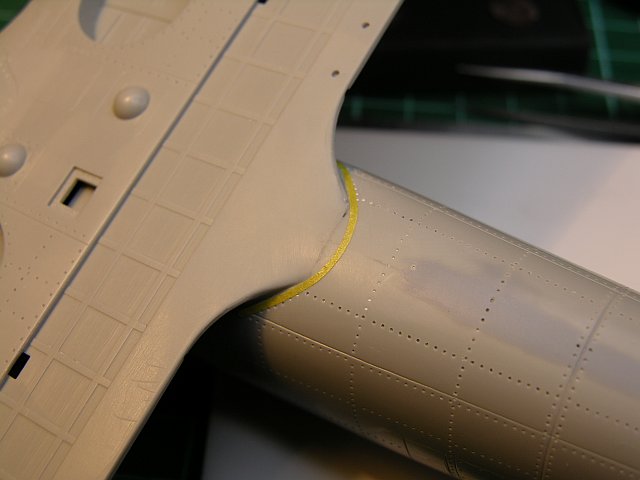
With the tape removed, the pencil line (since sanded away) can be used to provide a guide for the rivet line. A simple yet effective method
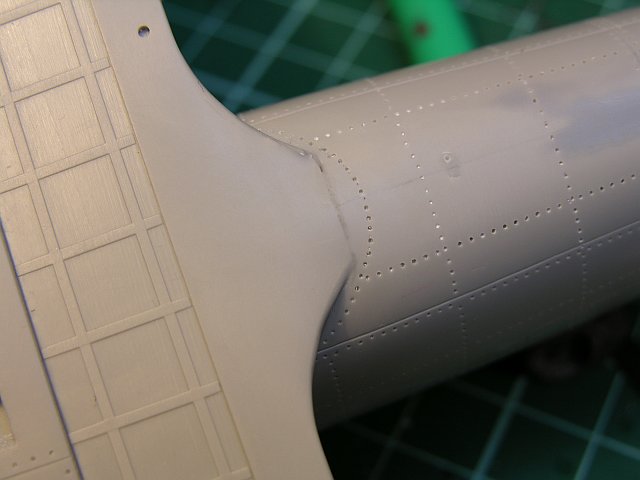
The lead sinkers have been packed into the nose and secured using two part epoxy glue. In order to fit the necessary lead in the limited space available, the exhausts had to be sacrificed. Not really a problem as we only need the small stubs that protrude outside the cowling (see below)
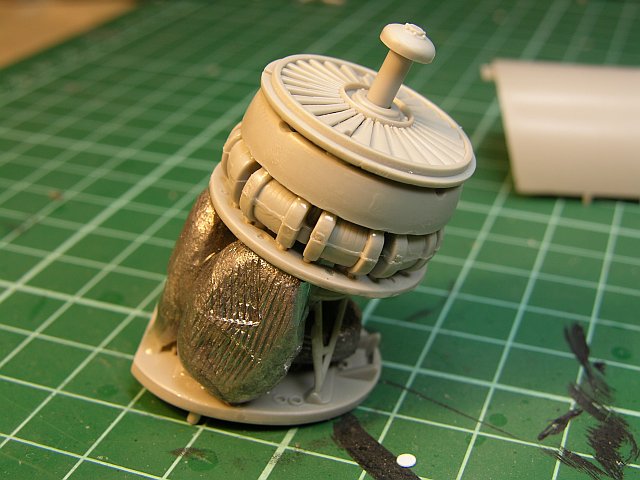
A quick coat of black paint helps hide any sinkers or glue that may be visible between the fuselage and cowling once attached
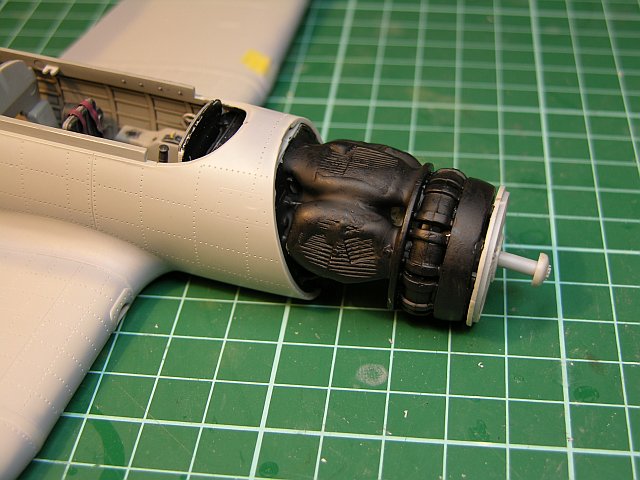
Here we can see how much of the original exhaust tubing remains (not much). Compare this photo to some of the earlier dry fitting to really appreciate how much got the chop

Time for a quick dry fit of the engine, fuselage and nose wheel. The fitting revealed that a small gap resulted and was subsequently filled with 80x60thou
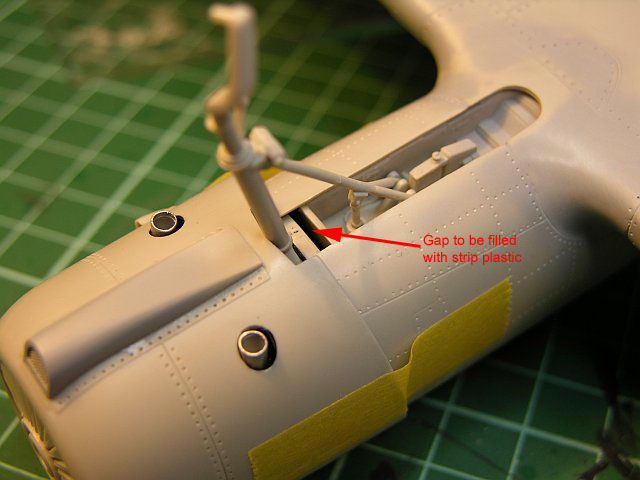
With the nose sealed up its time to test the success of the weights. To my relief, this models tail sitting days are well and truly over. During this process I realised that the main undercarriage would need additional support to reliably bear the added weight
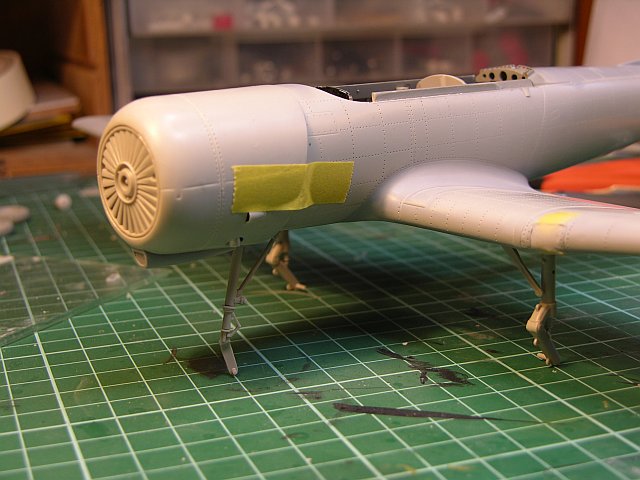
A simple enough job to pin the main undercarriage legs with brass rod. Its amazing how much extra stability just this short length of brass gives the model
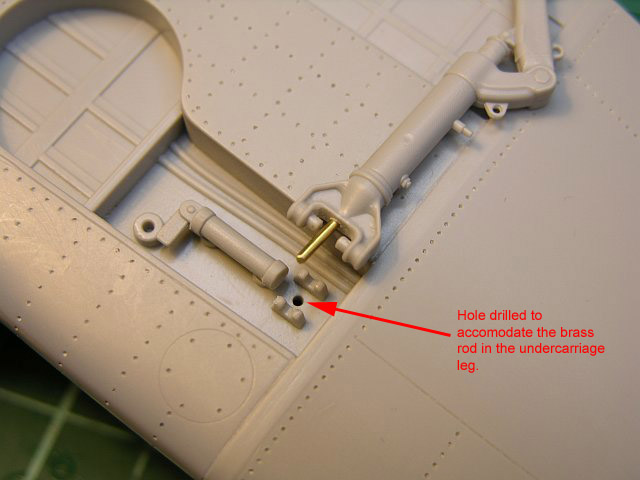
A close up shot of the pinned undercarriage in place. The brass ping is barely noticeable and will blend in completely when painted
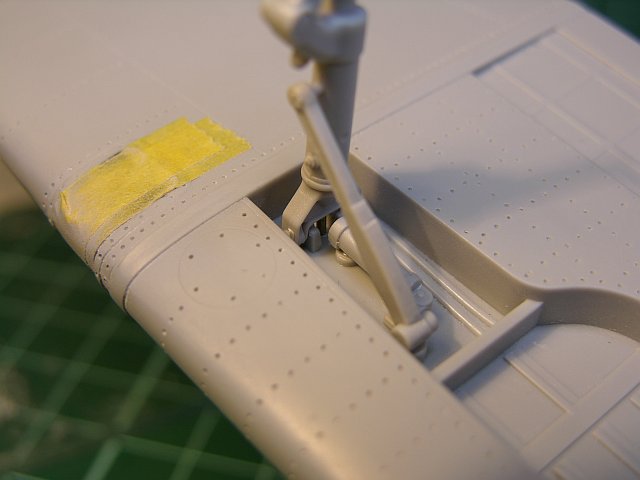
A readily available item that can be quickly used to mask tight circular holes (like the protruding exhausts on the bottom of the cowling) is plastic drinking straws. Cut them to length and if the hole you need to mask is smaller than the straw, simple slice the straw along its length. This way it can wrap in on itself, contracting as it does so. Secure it using a small strip of tape. A heck of a lot easier than trying to get masking tape in there

The wheel wells and air brake/flap recess will be painted natural metal (Alclad Airframe Aluminium). As an experiment, I have primed the areas with Tamiya Acrylic Semi Gloss black. Once dry they will be coated with Alclad. I have roughly masked the area's to avoid the thickish acrylic black overspray
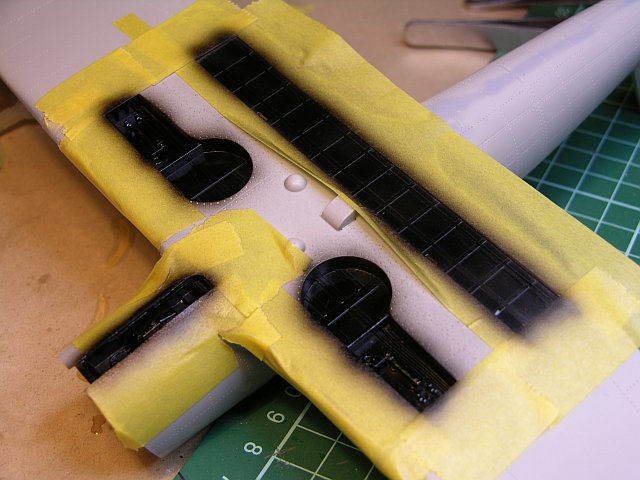
The kit undercarriage (based on my sparse reference photos) seems quite accurate. The only thing I wanted to add was simple hydraulic brake lines from copper wire. Here I have roughly laid out the wire and temporarily held it in place (using strips of Tamiya tape) in preparation for gluing with CA
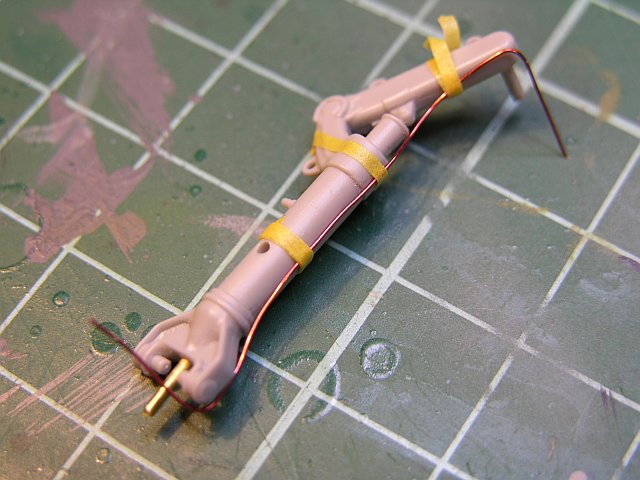
To simulate the retaining straps used on the brake lines, I have used lead foil (off a wine bottle cork) cut into thin strips and secured using CA (super) glue
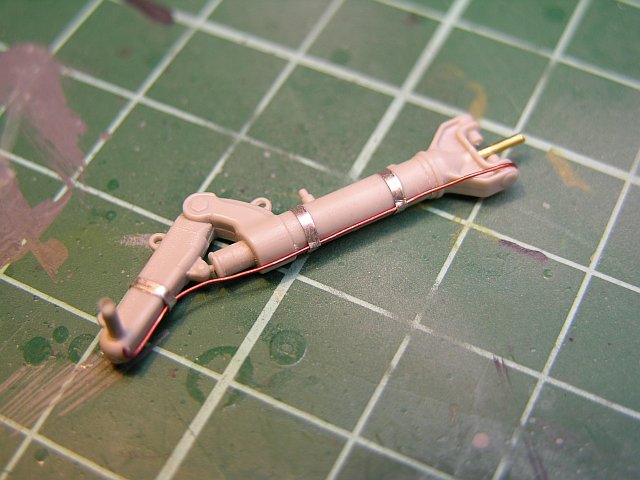
Trumpeter provides the wing tip nav lights molded in solid plastic. I cutaway the front section of the molded part and glued a section of clear sprue in place. When the glue was dry and the joint solid, I used a sharp knife and wet n dry paper to shape the light. This was then buffed using micromesh cloth to bring the clarity back into the clear part. These will be painted red and green appropriately (using Tamiya Clear paints)
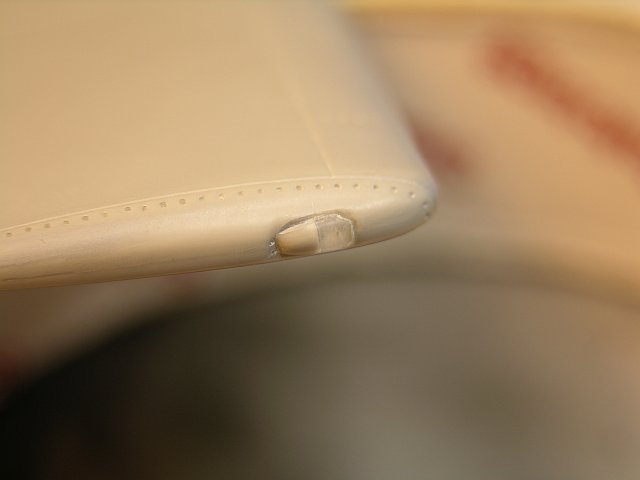
The interior of the canopy(s) has been masked (using Tamiya tape for the sharp edges and Maskol in the center) and the interior framing painted grey
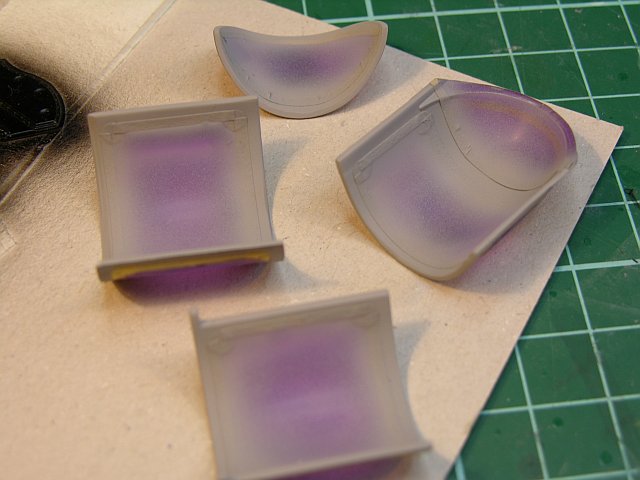
With the Alclad metalizer safely protected under a coat of Future, its time for the chrome struts to be simulated with Bare Metal Foil. I really like this stuff for small tasks like this. It looks so realistic once burnished on and is quite easy to apply being self adhesive
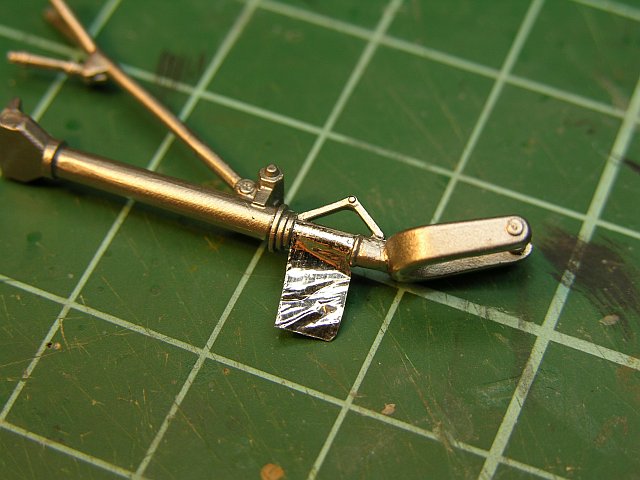
I had originally planned to scratch build a whole new propeller to better represent the shorter, thicker props on the civilian birds, but I have to admit that its taking me long enough to build this darn model, so I have settled for a less time consuming re-shaping of the tips of the kit prop. Here you can see the closest end has been chopped, whilst the red line indicates where the other end will be chopped
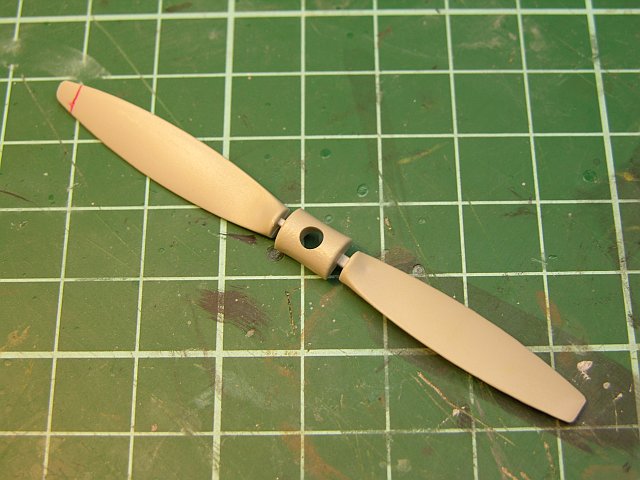
With the fixed part of the canopy safely glued in place (with CA) I needed to touch up the cockpit sills with grey. I've simply masked the interior edges with Tamiya tape to protect from overspray. Note the inclusion of a paper map in the rear cockpit
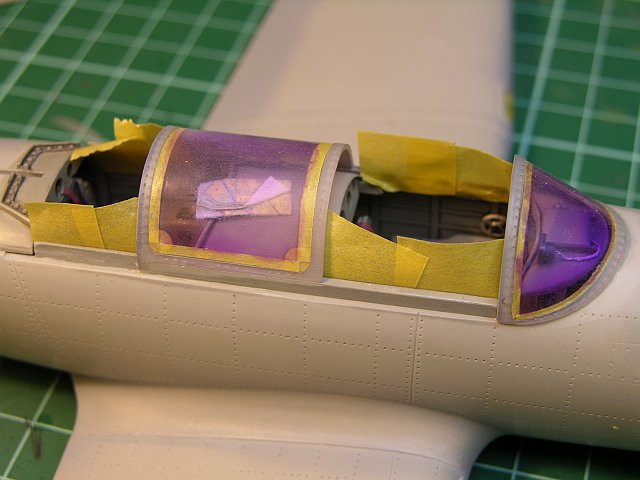
All masked up and ready for paint. The yellow tips on the nose, and wing tips have been painted already and masked
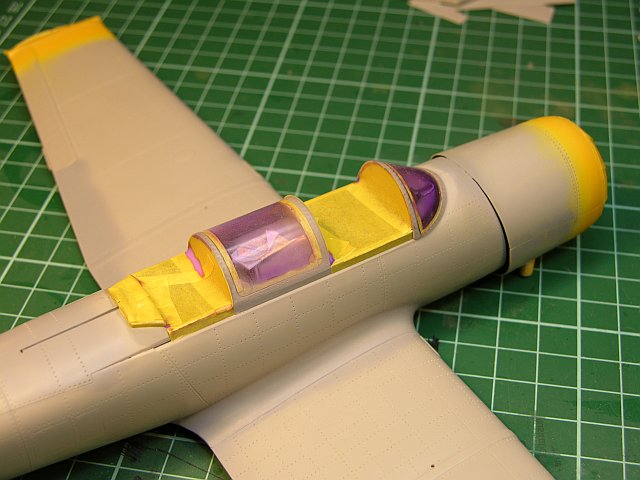
The tail has also received its yellow tips and masking
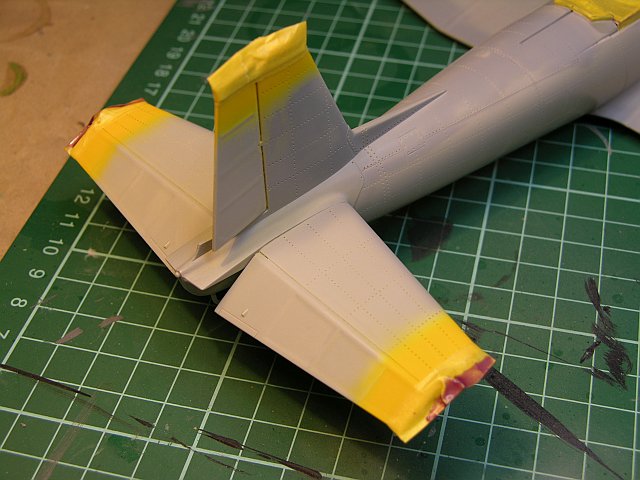
Last masking task is the wheel wells, wing light and brake/flap
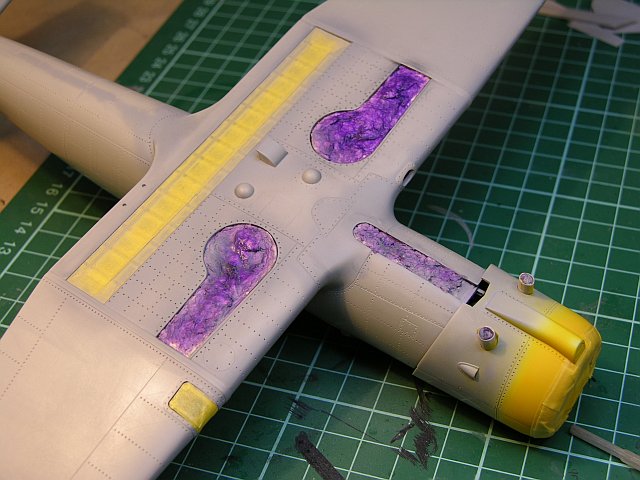
I've applied the underside color (Humbrol H130 + Humbrol H127 mixed in a ratio of 4:1) and when dry used Blu Tac and tape of mask off
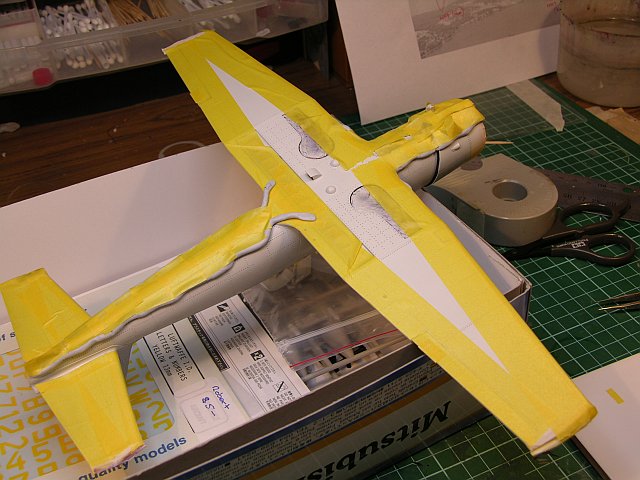
A close up of the blu tac masking technique I prefer. Next instalment, the Royal Blue upper surfaces
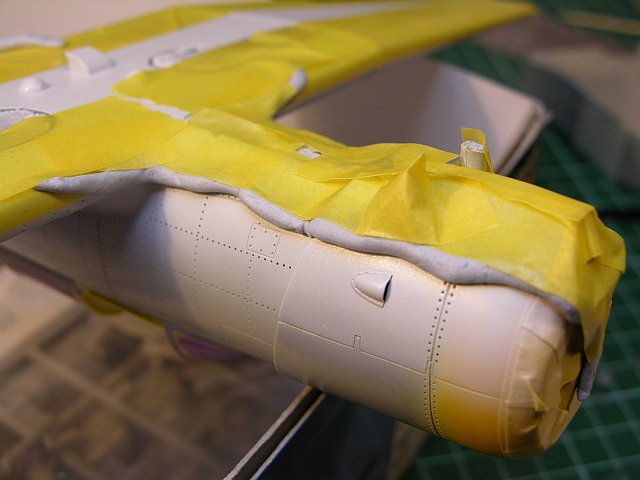
With the final coat of paint applied (Tamiya Acrylic X-3 Royal Blue) it was time to start doing something about the markings. I'd made decals on my inkjet printer before so with the help of a word processor and testors clear decal paper, I soon had some insignia yellow decals. The Chinese national markings would come from the kit sheet
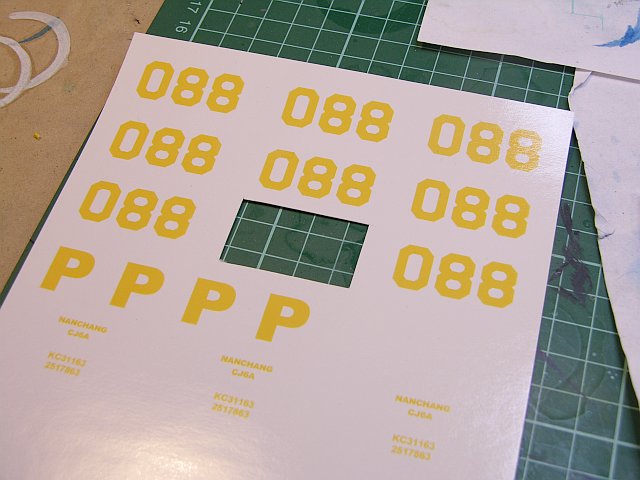
As I had used a scrap model to do a paint color test earlier, I thought it would be prudent to check the decals before applying to the model. Well, I had thought the yellow decals would need a couple of layers to bring the colour out, but as you can see, without a white backing (which I can't produce on an inkjet printer), the yellow decals looked anything but yellow. Hmmm. back to the drawing board
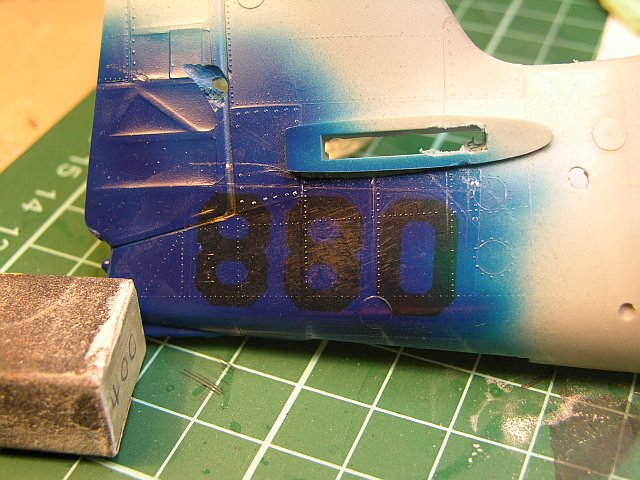
One option was to re-print the decals on white carrier film and then carefully cut them out. A second option was to create my own masks and paint the markings. As I had never tried this before, I decided to give it a shot. I went to my local art supply shop and purchased a sheet of self adhesive, Frisket film mask. This flexible, translucent masking material, is designed for exactly what I had in mind. The photo above shows the serial numbers, printed on normal paper and held in place over the Frisket film. Using a sharp blade and ruler, I cut thru the paper and the Frisket film underneath

Here the Frisket film has been removed from its backing sheet and applied to the model. Note that the center of the 0 has not yet been put in place
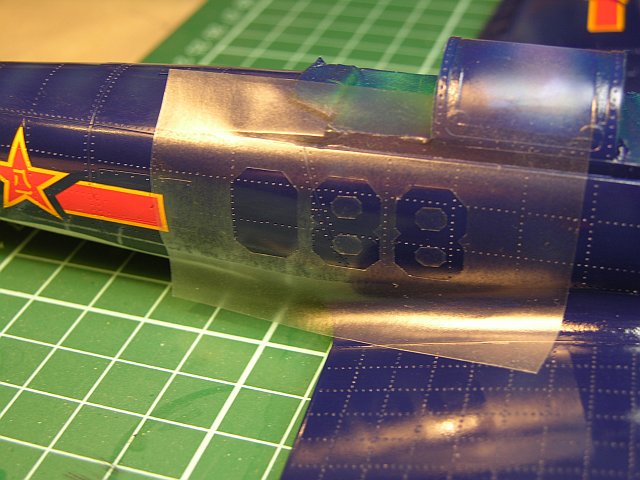
As yellow paint has the same problem as yellow decal unless backed by white, the first layer was Hum 130 Satin White
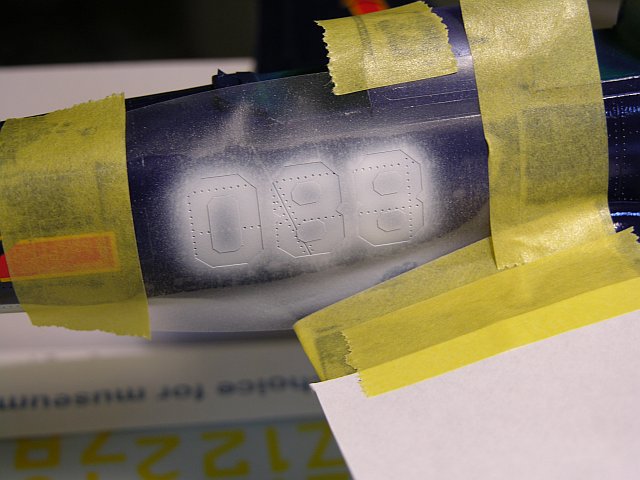
This was followed by Hum 154 Insignia Yellow
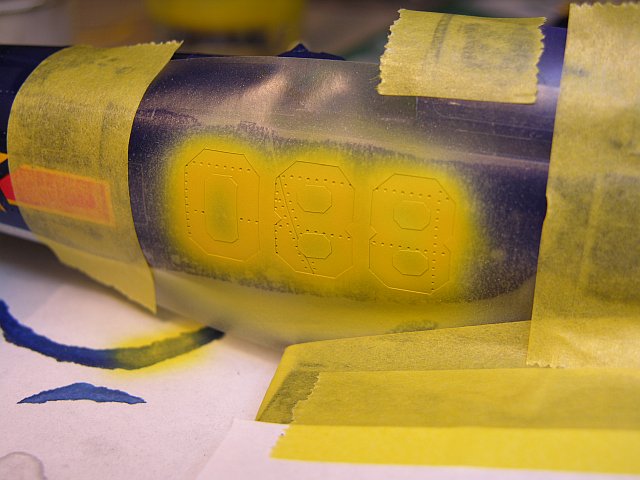
Given 10 minutes for the paint to set, the mask is gently removed and the end result visible. Overall I'm very happy with the result and it has the added benefit of perfectly color matching the wing, nose and tail tips
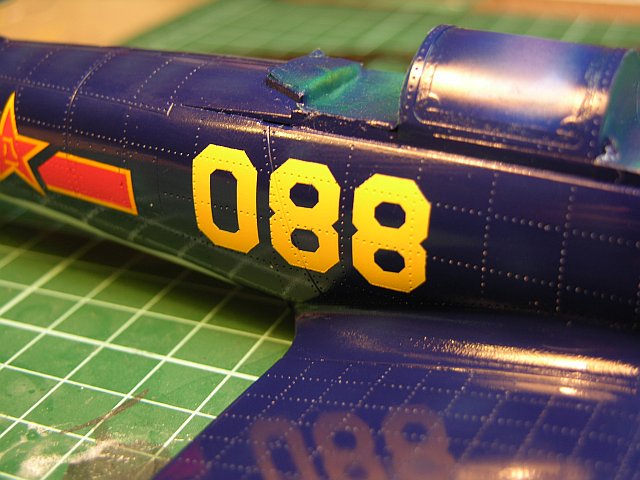
With the decals and markings complete, a thin coat of Future is used to seal everything up and then a panel wash is applied. Here the medium gray wash has been applied roughly over the panel and rivet lines. Once dry, this is removed using a clean cloth and thinners
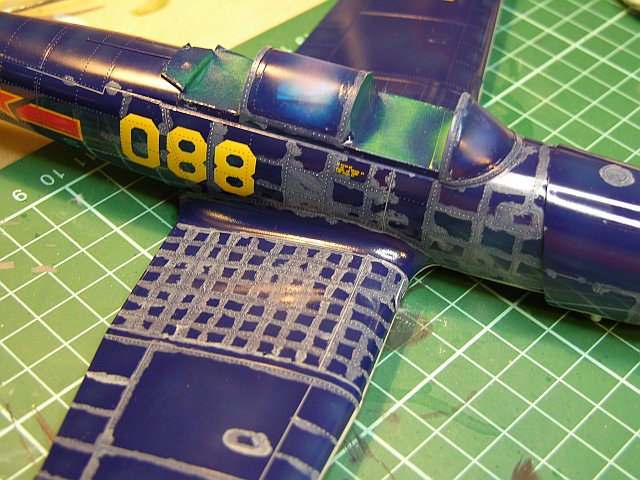
Final construction has been completed including canopies, undercarriage and other odds and ends. To dull down the high gloss finish, I used a custom mix of Poly S Flat and Satin clear. The end result is not matt, but hopefully a scaled down version of the real planes high gloss
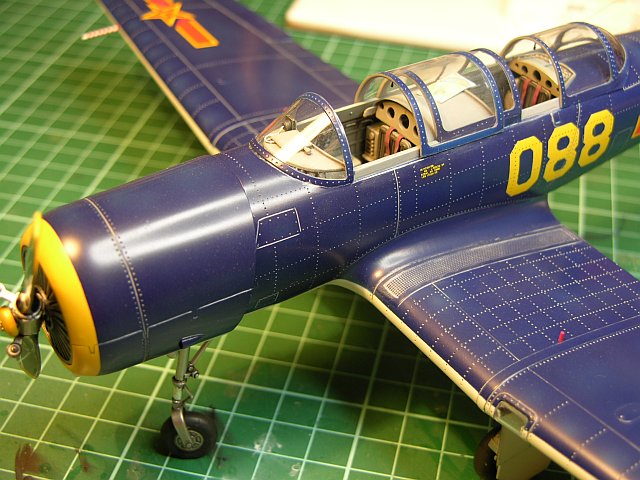
The prop has been temporarily attached as it still has a couple of decals to be applied
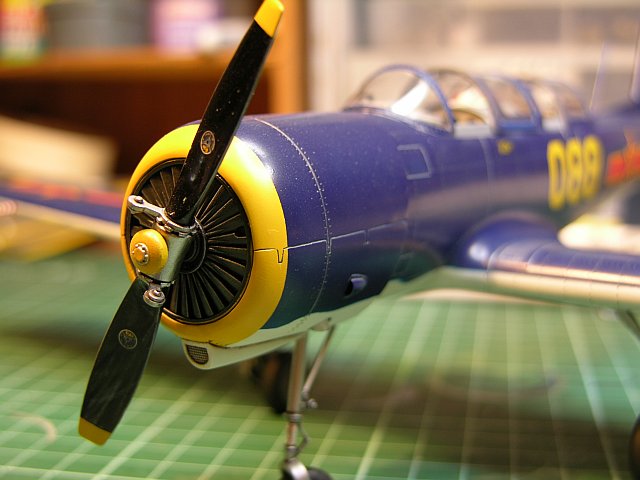
The cockpit (with map) can be quite clearly seen thru the large clear canopy
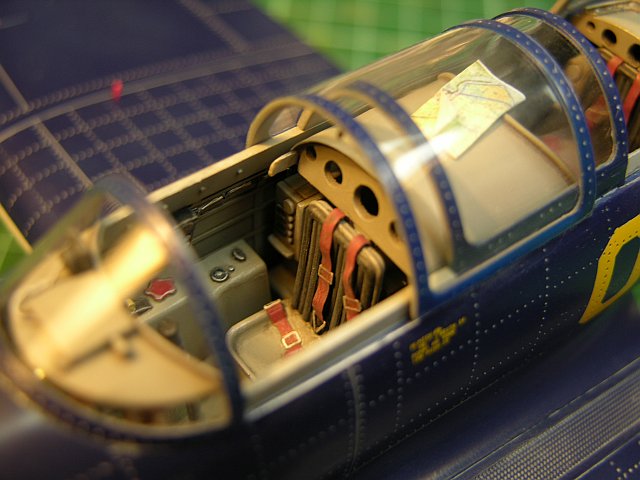
The panel and rivet lines look quite stark in this photo. In real life they do not jump out quite this much
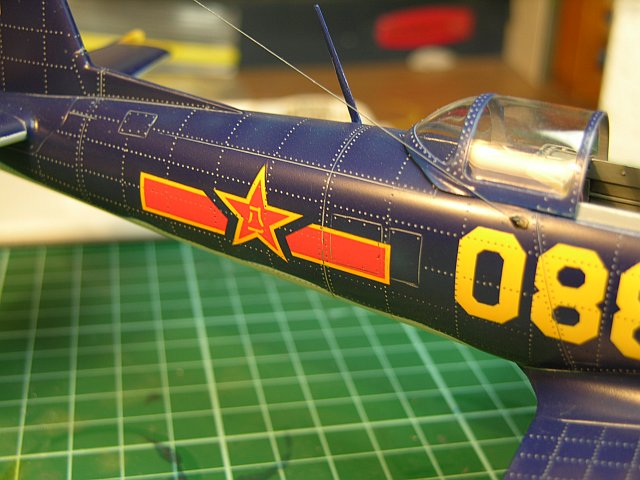
The undersides received some restrained weathering including a panel wash
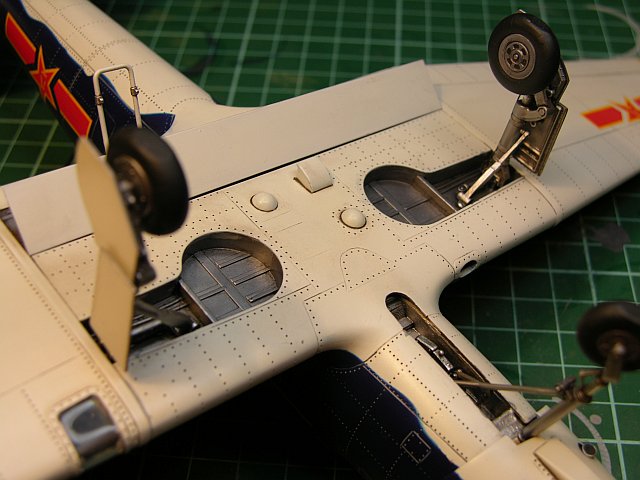
.jpg)
.jpg)
.jpg)